FAQs & Travel Tips for First-Time Visitors to Zermatt
Got questions about Zermatt? Don’t worry – we’ve got the insider tips, tricks, and need-to-know answers to make your first trip to this magical Swiss gem as smooth as a good fondue.
Welcome to our FAQs & Travel Tips for First-Time Visitors to Zermatt!
This is your ultimate guide to Zermatt – where the mountains are massive, the air’s so fresh it practically slaps you awake, and adventure is calling your name (loudly)!

In the Swiss Alps, bordering Italy, Zermatt’s a car-free slice of paradise that feels like stepping into another world – one where the only traffic you’ll deal with is the occasional ski lift queue.
Whether you’re here to ogle at the legendary Matterhorn, carve up the slopes on world-class pistes, or relax with a hot chocolate and soak up the alpine mood, a little local know-how goes a long way.
This handy little FAQ is your go-to travel buddy, stuffed with answers to all those burning first-timer questions. From getting your bearings on Zermatt’s super-charming (and wonderfully walkable) streets to hunting down the tastiest local eats, we’ve got your back.
Basically, if you’re looking for tips to make your trip unforgettable, you’re in the right place. Now, pack your cosiest jumper and get ready to make some mountain-sized memories.
Discover Zermatt contains affiliate links, if you make a purchase using one of these links, we may receive compensation at no extra cost to you. Read our disclaimer for more information.
FAQs for First-Time Visitors to Zermatt
We’ve listed these FAQs in order of how we think they will naturally come up in your trip planning to Zermatt, but feel free to zip around the page as you please!
General Zermatt, Switzerland Information
These are the most commonly asked general travel FAQs about visiting Zermatt:
Is Zermatt Safe for Tourists?
Zermatt is considered very safe, but like any travel destination, it’s wise to keep an eye on your belongings and be aware of your surroundings.

When is the Best Time to Visit Zermatt
The best time to visit Zermatt depends on what kind of experience you’re looking for. Winter, from December to April, is ideal for skiing and snowboarding, with world-class slopes and a magical alpine atmosphere.
Summer, from late June to September, is perfect for hiking, climbing, and enjoying the lush mountain scenery under clear skies.
Shoulder seasons like late Spring and Autumn—May, early June, and late October—offer fewer crowds and lower prices, though some lifts and trails may be closed. Whether you’re chasing powder or alpine wildflowers, Zermatt is spectacular year-round.
For more in-depth information, here’s our full guide:
The Best Time to Visit Zermatt
What Language is Spoken in Zermatt?
The main language spoken is Swiss German, which differs from German (also known as High German or Hochdeutsch), but German will be understood. Swiss German has many different dialects, and Zermatt has its very own version of ‘Zermatter Deutsch’.
You will hear locals using words that sound German, French and Italian, with a unique little Swiss spin on them. Merci Vielmal means ‘thanks a lot’ and is a mixture of French and German. You will also hear many people using Ciao.
Don’t stress! English is widely understood. Speaking German isn’t essential, as most people in tourism communicate in English. However, learning basic German phrases can enrich your interactions with locals and demonstrate cultural respect.
Here are five basic German words and phrases that can be handy for visitors to Zermatt:
Tag Wohl – Hello! (Other parts of Switzerland use ‘Grüezi’)
Danke – Thank you
Bitte – Please/You’re welcome
Entschuldigung – Excuse me/Sorry
Sprechen Sie Englisch? – Do you speak English?
These phrases should help you navigate basic interactions while enjoying your time in Zermatt!
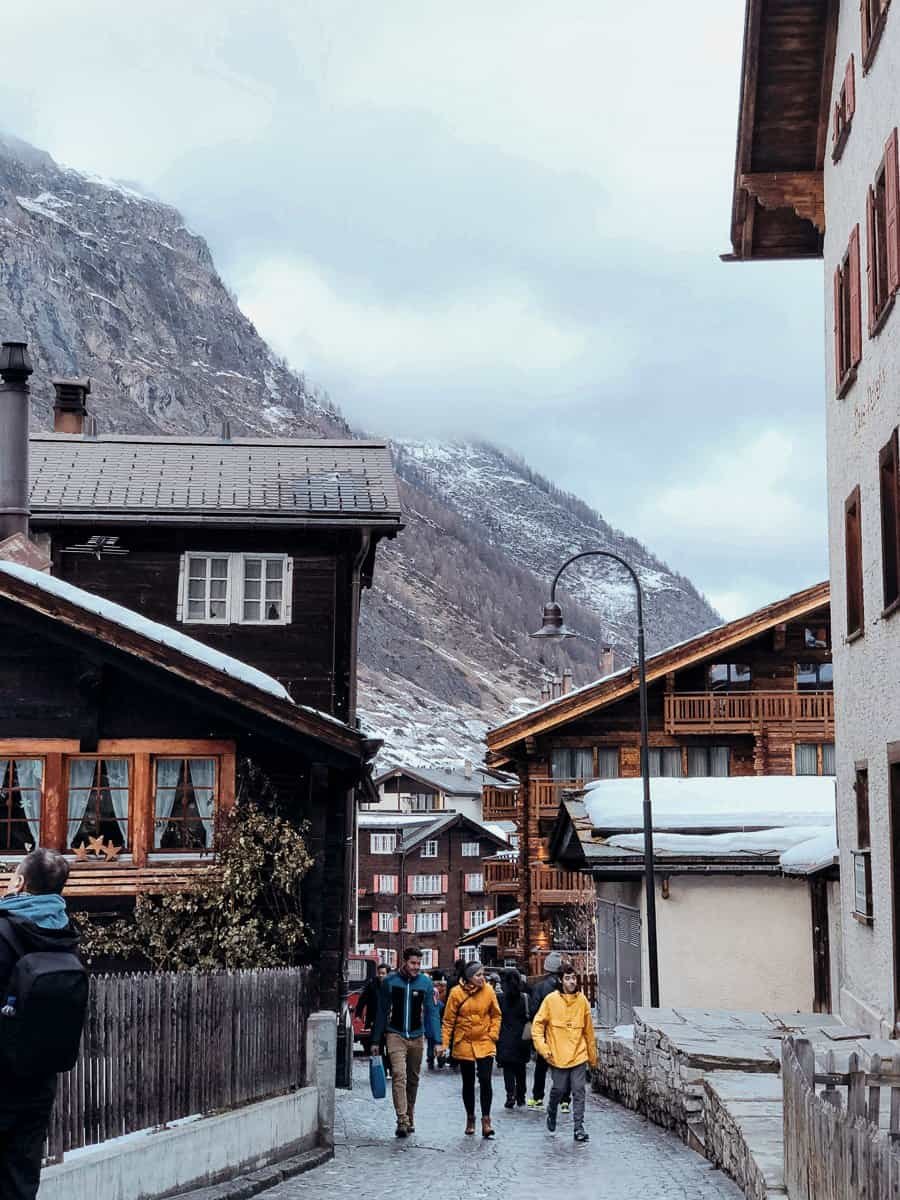
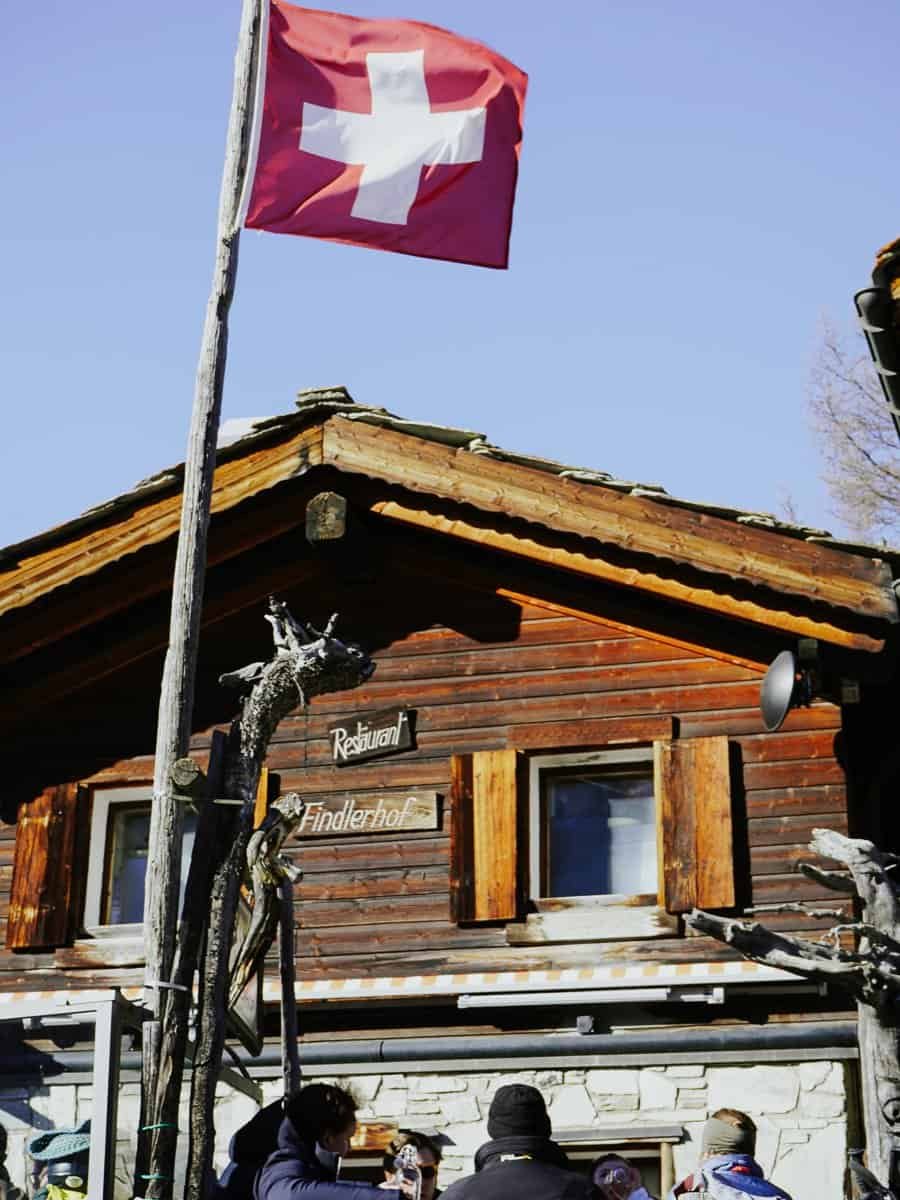
Booking Your Holiday?
Use our favourite travel resources to save time & money:
Best Accommodation Deals
Save on Swiss Train Travel
Affordable Airport Transfers
Excellent Tours & Activities
The best Flight Deals
Save on Car Hire
Don’t forget Travel Insurance
Are There Any Local Customs I Should Be Aware Of?
Swiss customs are generally polite and formal. Always greet with a friendly “Tag Wohl” and be punctual for appointments or reservations.
In Switzerland, the tradition of greeting with three kisses on the cheek is still practised, though it can vary by region and social context. This form of greeting is more common in the French-speaking part of Switzerland, while in the German-speaking areas, people might opt for a handshake or a hug instead.
The three-kiss greeting is typically used among friends, family, and close acquaintances. It’s less common in formal or business settings, where a handshake is usually preferred. However, personal preferences and the level of familiarity between individuals can influence whether this greeting is used.
What Currency is Used in Zermatt?
The Swiss Franc (CHF) is the currency used in Zermatt. While major credit cards are accepted in most hotels, restaurants, and shops, it’s handy to have some cash for smaller purchases, local transportation or in places like mountain huts that might not accept cards.
There are many cash withdrawal atms in Zermatt and one at the Täsch train station. The standard notes come in denominations of 10, 20, 50,100,200,1000. Take extra care not to misplace those bigger ones!
What Type of Outlet is Used in Zermatt?
Switzerland uses type C and type J plugs, and the standard voltage is 230 V with a frequency of 50 Hz. Most power sockets are designed to accommodate three-pin round plugs.
The Europlug, known as type C, features two round pins, these plugs are versatile, fitting into any socket that matches these dimensions and are also compatible with type J sockets, which have three round pins.
This compatibility offers convenience for travellers and residents alike, ensuring that devices can be easily plugged in without the hassle of adapters, provided they meet the pin, voltage and frequency requirements. It’s a good idea to bring a universal adapter if your devices use different plugs.
Where Can I Find Medical Facilities in Case of an Emergency?
In Zermatt, medical facilities are available to handle emergencies and provide healthcare services. Here are some options:
Doctors and Clinics: There are several private doctors and clinics in Zermatt that can provide medical assistance. It’s advisable to check with your accommodation for an up-to-date doctor’s schedule, as the clinics take it in turn to act as A&E.
Pharmacies: Pharmacies in Zermatt can provide over-the-counter medications and advice for minor health concerns. They can also direct you to medical facilities if needed.
In case of a serious emergency, it’s important to contact local emergency services by dialling 144. They can provide immediate assistance and transport to the nearest hospital in Visp, if necessary.
Emergency Number: 144
International Emergency Number: 112
Piste Patrol: +41 27 966 01 01

What Should I Do in the Event of a Skiing Accident?
If you have a skiing accident in Zermatt and need to contact the piste patrol, you can do so by calling the emergency number +41 27 966 01 01. This number connects you directly to the Zermatt Bergbahnen AG, which manages the ski area and can dispatch the piste patrol to your location.
It’s important to provide clear details about your location and the nature of the accident to ensure a swift response. Additionally, it’s always a good idea to have this number saved in your phone before heading out on the slopes.
The emergency numbers 144 and 112 will take you through to the call centre, which can coordinate with Piste Patrol, Air Zermatt and our local ambulance service.
Can I Drink from the Tap in Zermatt?
Yes, you can safely drink tap water in Zermatt. The water quality in Switzerland is generally excellent, and Zermatt is no exception. The tap water is clean, fresh, and often sourced from natural springs, making it perfectly safe and enjoyable to drink.
So refill your bottles for a sustainable way to stay hydrated.
Is Zermatt a Sustainable Destination?
Yes, Zermatt is considered a sustainable destination. The village has implemented several measures to promote environmental sustainability and reduce its ecological footprint:
Car-Free Village: Zermatt is renowned for being car-free, which significantly reduces air pollution and carbon emissions. Visitors travel by train and use electric taxis or walk within the village.
Renewable Energy: The resort heavily relies on renewable energy sources, particularly hydroelectric power, to operate its lifts and facilities, minimising its carbon footprint.
Sustainable Infrastructure: Many hotels and businesses in Zermatt are designed with sustainability in mind, featuring energy-efficient buildings and eco-friendly operations.
Waste Management and Recycling: Zermatt has effective waste management and recycling programs to minimise waste and promote sustainability.
Conservation Efforts: The resort actively engages in conservation efforts to protect the natural environment, including maintaining the pristine condition of the surrounding mountains and wildlife habitats.
These initiatives make Zermatt a leader in sustainability among tourist destinations, setting a benchmark for others to follow.

Planning Your Trip
These are the most commonly asked FAQs to help with trip planning to Zermatt:
Do I Need a Visa to Visit Zermatt?
Whether you need a visa to visit Zermatt depends on your nationality and the purpose and duration of your stay. Switzerland is part of the Schengen Area. If you’re from a country that is part of the Schengen Agreement, you generally won’t need a visa for short stays.
However, you may need a Schengen visa for tourism or business visits up to 90 days if you’re from outside the Schengen Area. It’s always best to check the latest entry requirements with the Swiss embassy or consulate in your country before you travel.
Do I Need Travel Insurance to Visit Zermatt?
No matter where you travel to, travel insurance is always a good idea, even if it’s within your own country. When planning a trip to Zermatt, it’s important to consider the potential risks and the necessity of travel insurance.
Zermatt is known for its mountain biking, hiking, climbing, skiing and snowboarding–activities that can lead to accidents or injuries. These activities often require specialised insurance policies. Helicopter cover can also be purchased with your ski pass if required.
Additionally, unexpected medical emergencies or trip cancellations can occur. Travel insurance provides crucial coverage for medical expenses, emergency evacuation, and reimbursement for trip interruptions.
Although it is not legally required to have travel insurance for visiting Zermatt, it is strongly advised for financial protection and peace of mind.
Getting Here & Where to Stay
Here are our top tips on Swiss saver passes, the best ways to get to and around Zermatt, plus insider advice on where to stay.
How to Get to Zermatt, Switzerland
To reach Zermatt, the easiest and most cost effective options are to fly to Zurich, Geneva or Milan and take the 3.5 – 4 hr train journey via Visp or Brig.
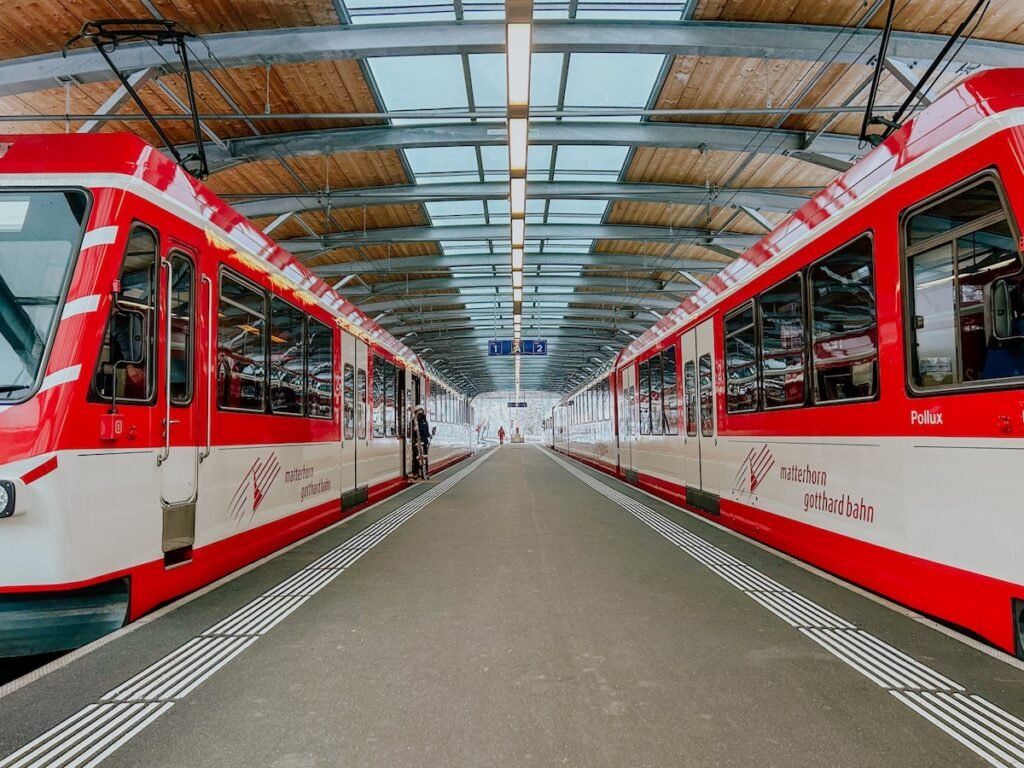
We highly recommend the Swiss Travel Pass, for train travel within Switzerland, it gives you unlimited travel by train, bus, and boat.
Vehicles can also be hired from all major cities and airports. As Zermatt is a car free village, all cars must be parked in Täsch, the most convenient parking is the Matterhorn Terminal Täsch at the train station.
If you don’t want the hassle of driving yourself or taking the train, private transfers can be arranged with Kiwi Taxi.
Getting Around Zermatt
Getting around Zermatt is easy. The village is car-free, so you’ll mostly wander on foot, but when you need to go further there are free little electric buses and paid taxis zipping about.
Want to head up the mountains? The Sunnegga funicular, Gornergrat Railway, and Matterhorn Glacier Paradise lifts will get you there in no time. And if you fancy something a bit different, you can even ride through town in a horse-drawn carriage.
The Swiss Travel Pass also gives you 50% off mountain railway and cable cars in Zermatt.
Where to Stay in Zermatt
Whether you’re visiting Zermatt for skiing, hiking, or a romantic getaway, there’s no shortage of charming places to stay. From affordable to luxurious, here are some of the best hotels in town:
Best Budget: Hotel Garni Testa Grigia
Bang for your buck with an excellent location.
Best Mid-Range: Unique Hotel Post
Various bars, restaurants and entertainment.
Best Luxury: BEAUSiTE Zermatt
Luxurious spa, dining experiences and Matterhorn views.
What Are the Best Accommodation Options in Zermatt?
Zermatt offers a variety of accommodations, from luxury hotels and cosy chalets to budget-friendly hostels and apartments. Consider your preferences for budget, amenities and proximity to ski lifts, hiking trails or the town centre for the best option for you.
Here’s our complete guide on:
Is Zermatt Accessible for People With Disabilities?
Zermatt is relatively accessible for those with disabilities. Many hotels, restaurants, and public areas are equipped with facilities to assist disabled visitors. Local transportation, including buses, taxis, trains and gondolas, are accessible. However, some of the older buildings and areas with natural terrain may present challenges.
What’s the Best Time to Visit Zermatt for Skiing?
The ski season typically runs from early December to late April, with peak conditions in January and February, depending on this year’s snowfall. The busiest times are during the peak weeks of Christmas, New Year and February half-term.
Is Zermatt Snowboard Friendly?
Zermatt is very snowboard-friendly. The resort offers a wide range of slopes suitable for snowboarders of all levels, from beginners to advanced riders. With its extensive network of well-maintained trails and off-piste opportunities, snowboarders can enjoy diverse terrain and stunning views.
Additionally, Zermatt features a winter and summer snow park with jumps and rails for those looking to practise tricks. Whether you’re cruising down the slopes or hitting the park, Zermatt provides a fantastic snowboarding experience.

Is Zermatt Fun if You Don’t Ski?
Zermatt is a fantastic winter destination, even if you don’t ski! Here are some activities and attractions you can enjoy:
Gornergrat Railway: Take a scenic train ride to Gornergrat for breathtaking views of the Matterhorn and surrounding peaks.
Hiking and Snowshoeing: Explore the beautiful trails around Zermatt, suitable for all levels, offering stunning landscapes and peaceful nature walks.
Matterhorn Museum: Discover the history and culture of the region with fascinating exhibits about mountaineering and local life.
Spa and Wellness: Relax and rejuvenate at one of Zermatt’s luxurious spas, offering a range of treatments and thermal baths.
Shopping and Dining: Enjoy the charming boutiques and shops, and savour delicious Swiss cuisine at the many restaurants and cafes.
Ice Skating and Curling: Try your hand at ice skating or curling at the local rinks for some fun winter activities.
Are There Any Special Events or Festivals in Zermatt?
Zermatt hosts various events throughout the year, including music festivals, marathons and traditional Swiss celebrations.
Horu Trophy – A popular curling tournament held in January.
Zermatt Unplugged – Our renowned acoustic music festival that takes place in April.
Patrouille des Glaciers – A ski mountaineering race, typically held in April every two years.
Gornergrat Zermatt Marathon – A challenging marathon event held in July.
Swiss National Day – August 1st, this day features festivities throughout Zermatt.
Zermatt Folklore Festival – In August, this festival showcases traditional Swiss culture.
Matterhorn Ultraks – The Ulitmate trail running event that takes place in August.
Zermatt Music Festival – A celebration of classical music in September.
Christmas Tree Lighting – December is the beginning of the holiday season in Zermatt.
Magic Mountain Zermatt – An electronic music and art festival held in December.

Can You Hike in Zermatt in the Winter?
Zermatt offers a variety of winter hiking trails that are well-maintained and marked, allowing you to enjoy the stunning snowy landscapes safely. These trails range from easy walks suitable for families to more challenging routes for experienced hikers.
Snowshoeing is also a popular activity, providing a unique way to explore our winter wonderland.
Is Zermatt Child Friendly?
Yes, Zermatt is very child-friendly! The town offers a variety of activities and attractions that are perfect for families with children. Here are a few highlights:
Family-Friendly Skiing: Zermatt has ski schools and gentle slopes ideal for kids learning to ski or snowboard. The Wolli Park for beginners at Sunnegga is a great spot for young ones to practice. Children up to nine can enjoy skiing for free with the Wolli Card.
Hiking Trails: There are several easy hiking trails suitable for families, offering stunning views and the chance to explore nature together.
Gorner Gorge: This is an exciting adventure for kids, with wooden walkways and bridges through a beautiful gorge.
Playgrounds and Parks: Zermatt has several playgrounds where kids can burn off energy and enjoy the fresh mountain air.
Matterhorn Museum: A visit to the museum can be both educational and entertaining for children, with interactive exhibits about the region’s history and mountaineering.
Family-Friendly Restaurants: Many restaurants in Zermatt offer child-friendly menus and welcoming atmospheres for families.
With these options, Zermatt provides a wonderful environment for a family vacation, ensuring both children and adults have a memorable experience.

Once You Have Arrived
These are the most commonly asked FAQs to help navigate your time and activities in Zermatt:
How Do I Get Around Zermatt?
Zermatt’s car-free policy means you can explore the village on foot, by bicycle or use electric taxis and buses for transportation. Zermatt is very walkable, but if your accommodation is not close to the train station, you may want to consider our efficient network of public transport with your heavy luggage.
The electro busses are an eco-friendly way to navigate our relatively small town, these are completely free for everyone to use.
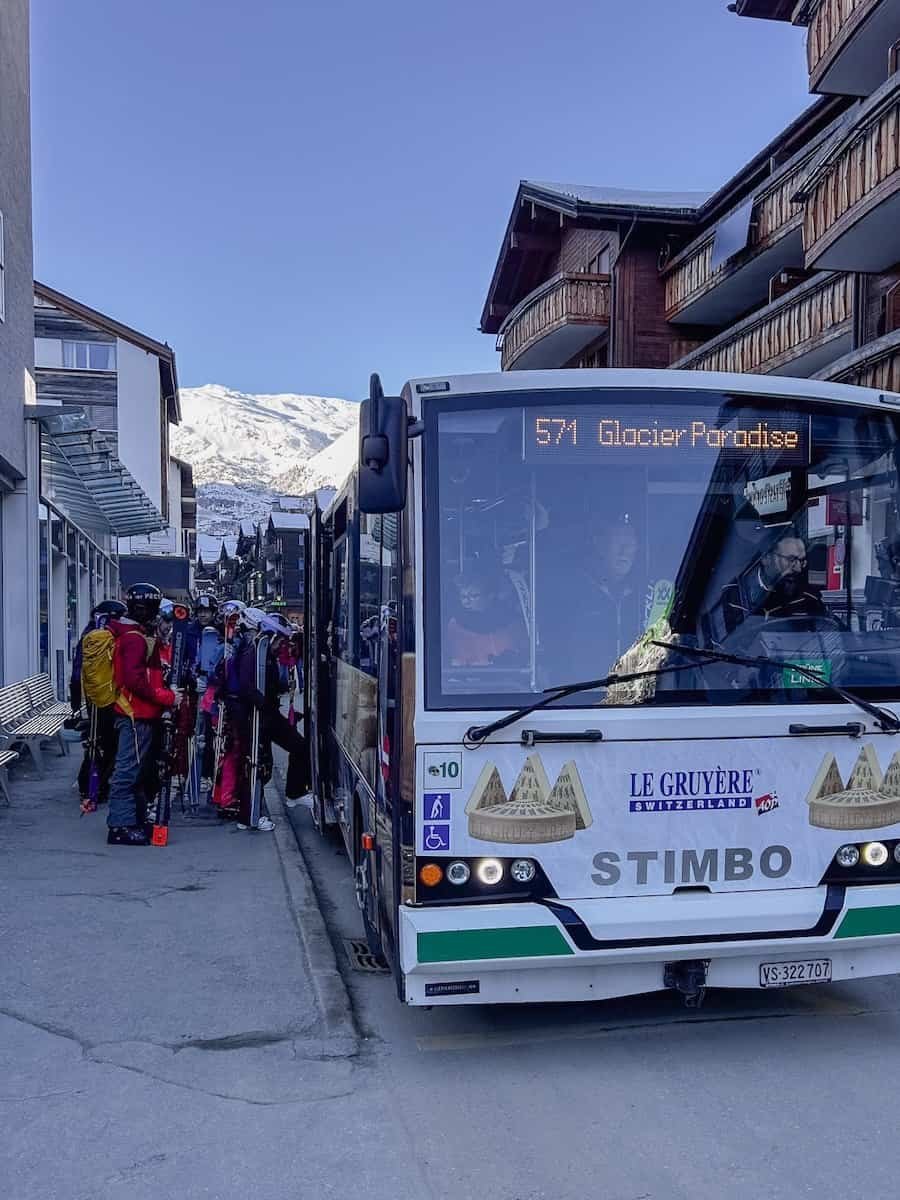
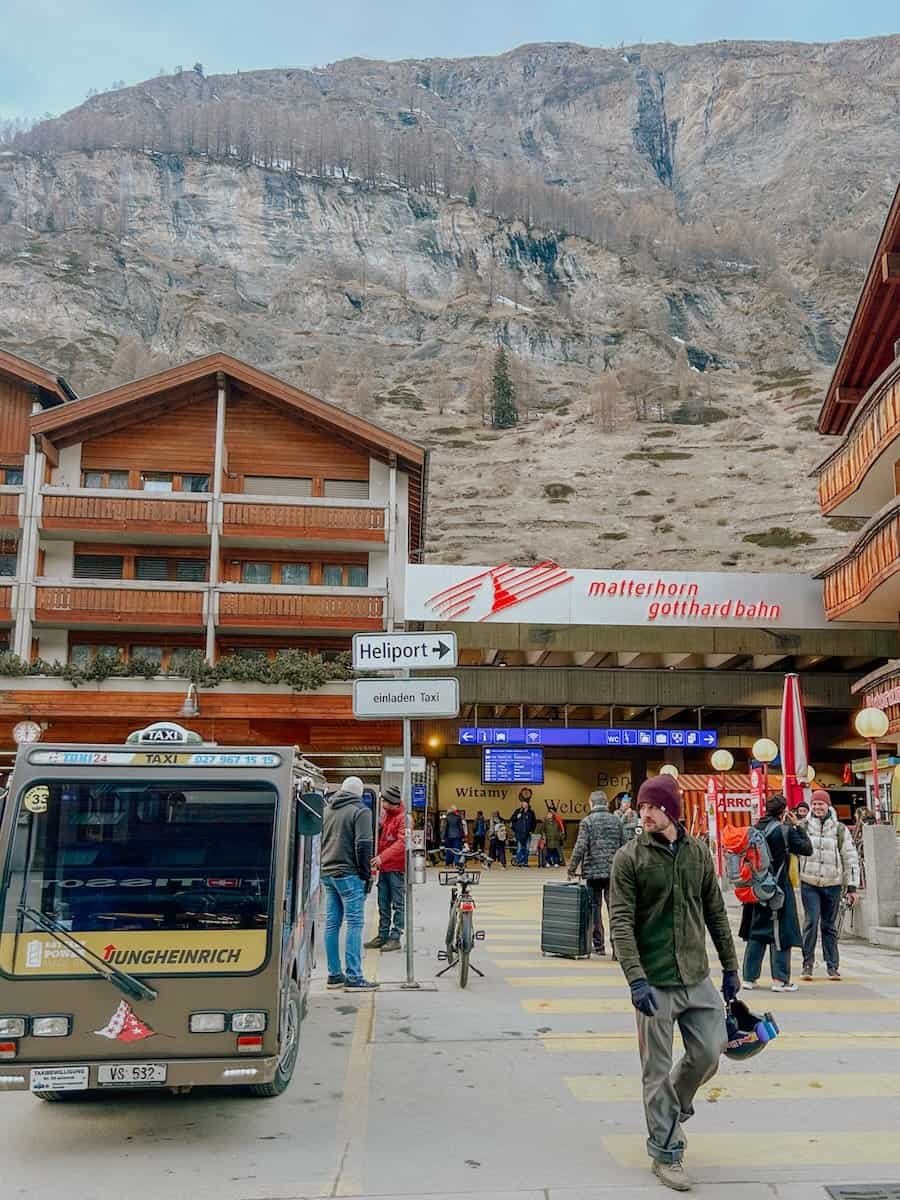
What Activities Are Popular in Zermatt?
In winter, skiing and snowboarding are top activities, while summer offers hiking and mountain biking. Don’t miss the Gornergrat Railway for stunning Matterhorn views and the Glacier Paradise for year-round snow fun.
What Dining Options Are Available in Zermatt?
Zermatt is known for its gourmet dining, with plenty of Swiss and international cuisine options. Try traditional dishes like fondue or raclette, and explore the charming mountain huts for a unique experience.
Here’s our guide to:
The Best Restaurants in Zermatt
Do I Need to Tip in Restaurants and Hotels?
Tipping is not mandatory in Switzerland, and a service charge is sometimes included in the bill, rounding up or leaving a small tip for exceptional service is appreciated but not expected.
Do I Need to Tip Instructors or Guides?
The same policy goes for guides and instructors. A tip is not expected but always appreciated for excellent service. Some guests opt to cover lunch for instructors they hire for the entire day. The choice is completely at your discretion and not a necessity.
Can I Visit the Matterhorn?
While climbing the Matterhorn is only suitable for experienced mountaineers, you can enjoy breathtaking views from several vantage points, like the Klein Matterhorn, Gornergrat and many places in the village.
To get up close and personal with the Matterhorn in the summer months, intermediate to advanced hikers can take the trail to the Hörnli Hütte.

What Can I Do if the Weather is Bad in Zermatt?
Even with 300 days of sunshine, there’s always the possibility of stormy days in the mountains, here are our top suggestions for bad weather days in Zermatt:
Matterhorn Museum: Dive into the history and mystique of the iconic Matterhorn at this fascinating museum. It’s a perfect way to spend a few hours learning about the local culture and mountaineering legends.
Spa Day: Treat yourself to some well-deserved relaxation at one of Zermatt’s luxurious spas. Unwind with a massage or soak in a hot tub while the storm rages outside. Blissful serenity is guaranteed.
Shopping Spree: Wander through Zermatt’s charming boutiques and local shops. From Swiss watches to traditional crafts, there’s something for everyone. Plus, you might find that perfect souvenir to remember your trip.
Dining Delights: Cosy up in one of the many restaurants and cafes. Savour hearty Swiss cuisine by a roaring fire and let the culinary delights transport you to foodie heaven.
Indoor Sports and Entertainment: Check out the local indoor sports facilities. Whether you’re into tennis, swimming or trying your hand at indoor climbing, there’s plenty to keep your adrenaline pumping indoors.
Check out our complete guide:
Best Indoor Activities for Bad Weather in Zermatt


Zermatt Travel Tips
Here are some additional travel tips from our local experts, to ensure your trip to Zermatt goes as smoothly as possible.
What To Wear in Zermatt
When planning your wardrobe for Zermatt, think layers, layers, layers! The alpine climate means you’ll need to be ready for chilly winds and sudden weather changes.
For skiing, pack thermal underlayers, a waterproof ski jacket, and insulated pants to stay cosy on the slopes. Don’t forget a good pair of ski gloves, socks, goggles, and a helmet for safety.
If hiking is on your agenda, opt for moisture-wicking base layers, breathable fleece, and sturdy hiking boots. As you explore the car-free village with its charming cobblestone streets, keep things casual yet warm with a comfy sweater, jeans, and a windproof jacket.
A hat and scarf are great for added warmth in colder months, and a sturdy pair of walking shoes will keep your feet happy as you wander through this picturesque alpine paradise.
Don’t forget sunscreen and sunglasses in every season, Zermatt averages 300 sunny days per year!
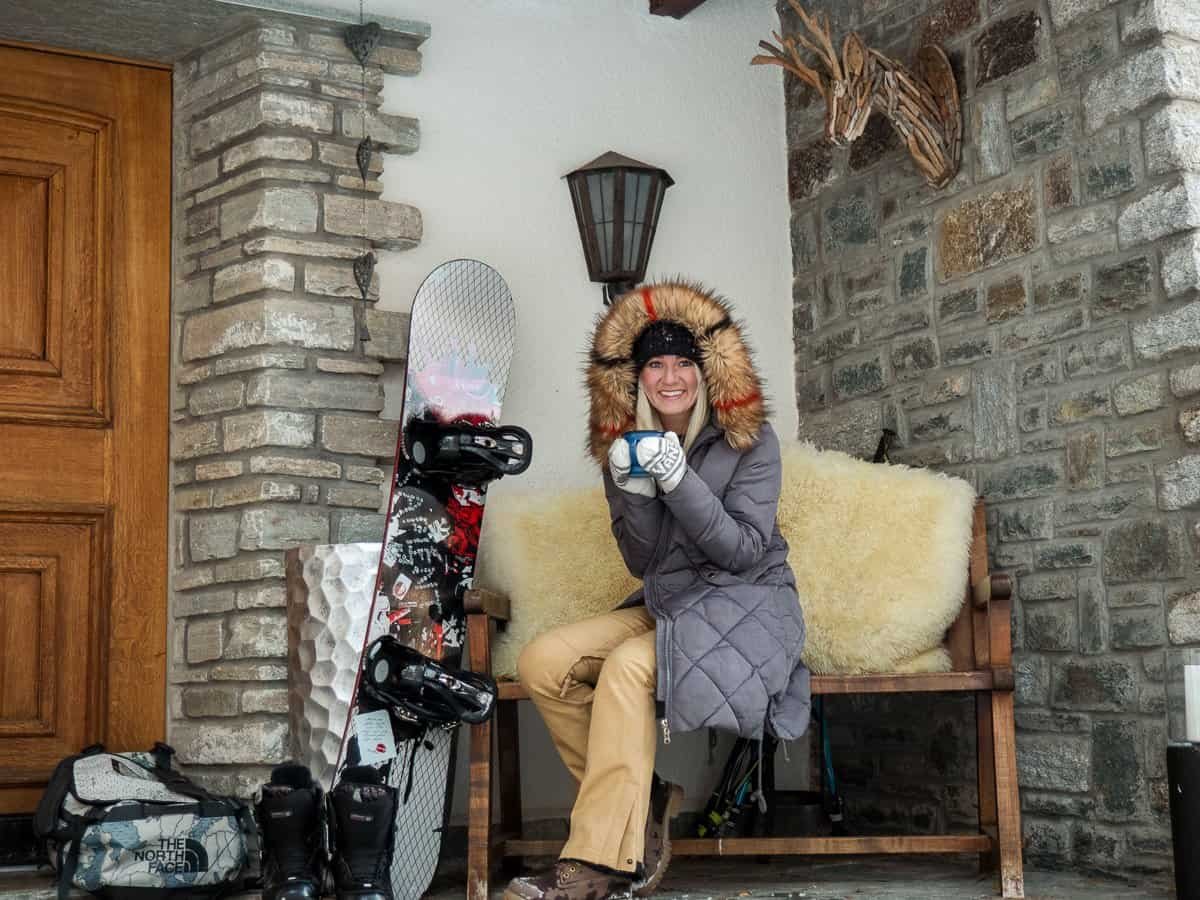
Hiking Etiquette
When you’re hitting the trails in Zermatt, keeping a few hiking etiquette tips in mind can ensure a peaceful experience for everyone. First and foremost, always stay on marked paths to protect the delicate alpine ecosystem and avoid getting lost.
Respect wildlife by keeping a safe distance and never feeding animals, as this disrupts their natural habits. When sharing the trail, yield to those going uphill and be courteous by stepping aside to let faster hikers pass.
Carry out all trash, including biodegradable items, as these can harm the local environment. It’s also wise to use a reusable water bottle to minimise waste.
Keep noise levels down to preserve the tranquillity of the mountains, and consider using trekking poles with rubber tips to protect the trail surface. Lastly, check the weather conditions and trail status before setting out, and let someone know your route for safety.
By following these tips, you’ll help maintain the stunning beauty of Zermatt’s trails for everyone to enjoy.

Skiing & Snowboarding Etiquette
When you’re carving through the snowy slopes of Zermatt, keeping etiquette in mind is key to a safe and enjoyable experience. First up, always maintain control and adjust your speed to match your skill level and the conditions of the run—after all, nobody wants to be the star of an unplanned snowball effect!
Respect other skiers and snowboarders by giving them plenty of space and always yield to those below you, since they can’t see you coming. Follow the resort’s rules and signage; they’re there to keep everyone safe and the slopes in tip-top shape.
Lift line etiquette is crucial too—no cutting or jostling, just patience and smiles as you wait your turn. Ensure your equipment is in good working order before hitting the slopes, and keep an eye out for weather changes and posted warnings.
By being aware of your surroundings and courteous to fellow snow sports lovers, you’ll contribute to a harmonious mountain experience that everyone can enjoy.

Photography & How to Capture the Matterhorn
Capturing the stunning beauty of the Matterhorn is a photographer’s dream, and with a few handy tips, you can bring home some truly breathtaking shots. Start by timing your photo sessions around the golden hours—early morning or late afternoon—when the lighting adds a magical touch to your images.
For iconic shots, head to locations like Gornergrat, Viewpoint Kirchbrücke or Zermatt Matterhorn Viewpoint, at any time of year. During summer, head to Stellisee Lake, where the Matterhorn majestically reflects in the water. A sturdy tripod is your best friend here, providing stability for those perfect low-light long-exposure shots.
Don’t shy away from experimenting with angles; get low for dramatic landscape shots or go high for panoramic views. Pay attention to the weather, as clouds and fog can add a mystical mood to your photos.
Diversify your portfolio by capturing both the sweeping landscapes and intricate details—like a close-up of a frosty pine or the charming architecture in the village. Always ask for permission before taking photos of locals or private properties to respect people’s privacy.

The Best Apps
These are the best apps to use to help organise your days here in Zermatt:
MeteoSwiss & yr.no: These apps provide the most accurate weather forecasts, helping you plan your outdoor activities around the alpine weather conditions.
Matterhorn App: Essential for skiers, this app offers real-time lift status, ticket information, and trail maps, ensuring you make the most of your time on the slopes.
Zermatt Unplugged App: If you’re visiting in April, this app is perfect for keeping track of the schedule and locations of events during the Zermatt Unplugged music festival.
FAQs & Travel Tips for First-Time Visitors to Zermatt Summary
Whether you’re skiing down snowy slopes in winter or hiking through vibrant summer trails, Zermatt is worth visiting year-round. To get there, you’ll park in Täsch and enjoy a scenic train ride, as cars aren’t allowed in the village.
Once in town, the iconic Matterhorn awaits as a must-see, alongside breathtaking views from Gornergrat and cultural insights at the Matterhorn Museum.Embrace local customs by greeting with a friendly “Grüezi.”
While English is widely spoken, a touch of Swiss German is appreciated. Prepare for the altitude with layered clothing and savour local delights like raclette or fondue after a day of skiing, snowboarding, or summer hiking.
If we’ve missed any burning questions, feel free to contact us and fire away!
© Discover Zermatt, Zermatt Bergbahnen, Zermatt Tourismus, My Switzerland
Plan Your Perfect Trip to Zermatt
Ready to dive deeper into planning your visit?
Our essential guides help make the most of your time in the mountains.
Getting Here
Trains, transfers & travel tips
Where to Stay
The best hotels, chalets & apartments
What to Do
Skiing, hiking & year-round activities
Where to Eat
Restaurants, fondue & hidden gems
Zermatt FAQs
Everything you need to know
